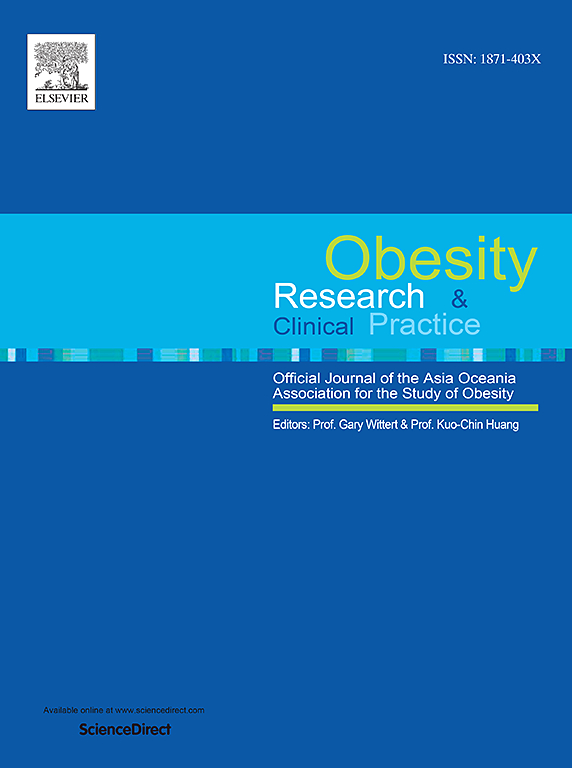Association of a healthy lifestyle index with anthropometric indices and obesity in Hong Kong Chinese women: Evidence from the MECH-HK cohort study
IF 2.5
4区 医学
Q3 ENDOCRINOLOGY & METABOLISM
引用次数: 0
Abstract
Aim
This cross-sectional study aimed to examine the associations of a healthy lifestyle index (HLI) with several anthropometric indices and obesity among Hong Kong Chinese women.
Subjects/Methods
A total of 3174 women (56.16 ± 8.43 years) were included. The HLI consisted of diet, physical activity, sedentary time, sleep duration, skipping breakfast, smoking, and alcohol. Each factor was scored as 0 (unhealthy) or 1 (healthy). The overall HLI was the sum of these points, ranging from 0 (the least healthy) to 7 (healthiest). Percent body fat (PBF), body fat mass (BFM), fat free mass (FFM), waist circumference (WC), waist-to-hip ratio (WHR), height, and weight were measured using the InBody 270 device.
Results
The number of women with 0–2, 3, 4, 5, 6–7-point HLI groups were 551, 759, 954, 645, and 265, respectively. As HLI increased, most anthropometric indices declined while FFM increased. The adjusted βs (95 % confidence intervals (95 % CIs)) for PBF (%), BFM (kg), WC (cm), WHR, height (cm), weight (kg), BMI (kg/m^2), and FFM (kg) were −0.653 (-0.829, −0.476), −0.582 (-0.751, −0.414), −0.719 (-0.971, −0.467), −0.005 (-0.006, −0.004), −0.181 (-0.347, −0.015), −0.602 (-0.850, −0.355), −0.188 (-0.282, −0.095), and 0.339 (0.213, 0.465), respectively. Additionally, compared to the 0–2-point group, the odds ratios (95 % CIs) of the 6–7-point groups were 0.54 (0.38–0.75) for central obesity and 0.55 (0.37–0.82) for general obesity.
Conclusions
HLI was inversely associated with PBF, BFM, WC, WHR, height, weight, BMI, central obesity, and general obesity, but was positively associated with FFM.
香港华裔女性的健康生活方式指数与人体测量指数和肥胖的关系:来自 MECH-HK 队列研究的证据。
目的:本横断面研究旨在探讨健康生活方式指数(HLI)与香港华裔女性多项人体测量指数和肥胖的关系:共纳入 3174 名女性(56.16 ± 8.43 岁)。HLI包括饮食、体力活动、久坐时间、睡眠时间、不吃早餐、吸烟和饮酒。每个因素的得分均为 0(不健康)或 1(健康)。总的 HLI 是这些分数的总和,从 0(最不健康)到 7(最健康)不等。使用 InBody 270 设备测量了体脂百分比 (PBF)、体脂质量 (BFM)、无脂肪质量 (FFM)、腰围 (WC)、腰臀比 (WHR)、身高和体重:结果:HLI 为 0-2、3、4、5、6-7 分的女性人数分别为 551、759、954、645 和 265 人。随着 HLI 的增加,大多数人体测量指数下降,而 FFM 增加。PBF (%)、BFM (kg)、WC (cm)、WHR、身高 (cm)、体重 (kg)、BMI (kg/m^2) 和 FFM (kg) 的调整 β 值(95 % 置信区间 (95 % CIs))分别为 -0.653 (-0.829, -0.476), -0.582(-0.751,-0.414)、-0.719(-0.971,-0.467)、-0.005(-0.006,-0.004)、-0.181(-0.347,-0.015)、-0.602(-0.850,-0.355)、-0.188(-0.282,-0.095)和 0.339(0.213,0.465)。此外,与 0-2 分组相比,6-7 分组中心性肥胖的几率比(95 % CIs)为 0.54(0.38-0.75),全身性肥胖的几率比(95 % CIs)为 0.55(0.37-0.82):HLI与PBF、BFM、WC、WHR、身高、体重、BMI、中心性肥胖和全身性肥胖成反比,但与FFM成正比。
本文章由计算机程序翻译,如有差异,请以英文原文为准。
求助全文
约1分钟内获得全文
求助全文
来源期刊

Obesity research & clinical practice
医学-内分泌学与代谢
CiteScore
7.10
自引率
0.00%
发文量
80
审稿时长
49 days
期刊介绍:
The aim of Obesity Research & Clinical Practice (ORCP) is to publish high quality clinical and basic research relating to the epidemiology, mechanism, complications and treatment of obesity and the complication of obesity. Studies relating to the Asia Oceania region are particularly welcome, given the increasing burden of obesity in Asia Pacific, compounded by specific regional population-based and genetic issues, and the devastating personal and economic consequences. The journal aims to expose health care practitioners, clinical researchers, basic scientists, epidemiologists, and public health officials in the region to all areas of obesity research and practice. In addition to original research the ORCP publishes reviews, patient reports, short communications, and letters to the editor (including comments on published papers). The proceedings and abstracts of the Annual Meeting of the Asia Oceania Association for the Study of Obesity is published as a supplement each year.
 求助内容:
求助内容: 应助结果提醒方式:
应助结果提醒方式:


